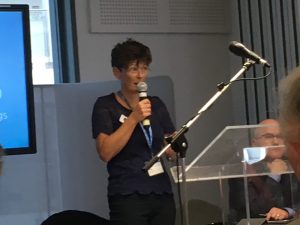On Friday, September 21, Amber Rudd MP chaired an hour long public meeting at South Coast College concerning the proposed closure of the Hastings walk-in medical centre, located next to the station. Joining her on the panel were Hastings Borough Council leader Peter Chowney and Executive Director of Health and Care Strategy, Amanda Philpott along with representatives from the NHS and IC24, the not for profit Social Enterprise that runs the centre.
Thirty-three members of the public joined the six person panel. The meeting began with Rudd’s introduction and the purpose of the walk-in centre was outlined by IC24.

Philpott made it clear in her remarks that the decision to close the centre was not about money. She was adamant that the efficient allocation of services, expertise and resources was the primary reason for proposing the relocation of the centre to the Conquest Hospital. This was part of a country wide roll out of the establishment of Urgent Treatment Centres (UTCs) to be in place by 2019. The UTCs may be good news but the concern was raised that these should be in addition to the walk-in centre in Hastings and not an alternative to it.

Philpott went on to say that there was public confusion about the distinction between the walk-in centre and A&E, and what constitutes appropriate use of both. This assertion was promptly challenged by a member of the public, Fiona Pienkowska, who made it clear that she, her friends and the public generally were perfectly capable of making the distinction, a claim supported by data provided by the medical centre which show that in a three month period, of 4,800 walk in patients, only 12 were sent to A&E.
After the meeting closed, Philpott conceded that the services provided by the centre had an important triage function, and that perhaps several centres throughout the area would provide a better and more comprehensive solution. The general dissatisfaction felt by the public concerning the efficiency and the perceived remoteness of the 111 service makes the availability of such walk-in centres an important issue for the entire area. As at present the closest such centres are Woodchurch and Hastings.
Chowney was next to contribute representing the public concern that the walk-in centre played an integral part in the lives of those who work in the town as well as those of students, young professionals and other members of the public who cannot access a GP. He raised concerns about transport links and costs and the effect of moving the service to the hospital and away from the easy accessibility of the town centre. This was echoed by those in attendance whose experience clearly represents that of the community at large. More than 20,000 members of the public used the centre last year.
Rudd went on to thank Chowney for his “eloquent putting of the case” and his ongoing efforts and voiced her own concerns for the survival of the centre, vowing to continue the campaign to save it, and leaving the door open for a united front in the fight to save a valuable resource.
Image Credits: Amber Rudd , Gerard Reilly .



